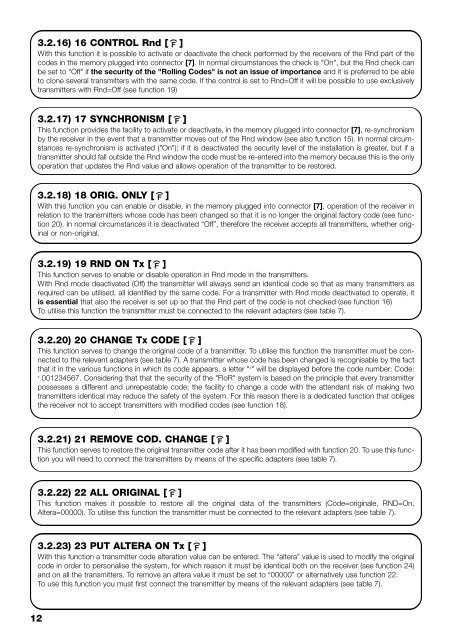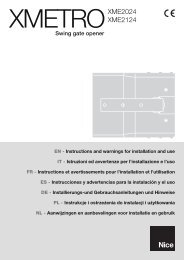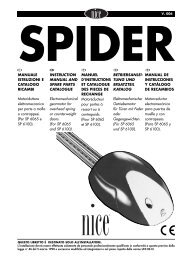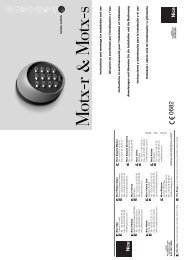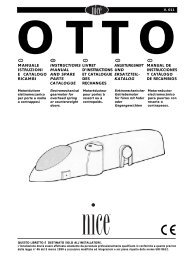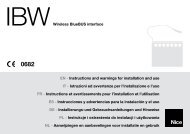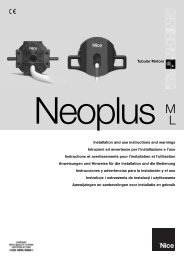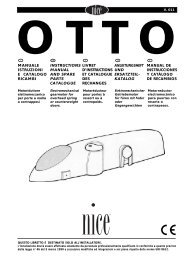F - Nice-service.com
F - Nice-service.com
F - Nice-service.com
- No tags were found...
You also want an ePaper? Increase the reach of your titles
YUMPU automatically turns print PDFs into web optimized ePapers that Google loves.
3.2.16) 16 CONTROL Rnd [ F ]With this function it is possible to activate or deactivate the check performed by the receivers of the Rnd part of thecodes in the memory plugged into connector [7]. In normal circumstances the check is "On", but the Rnd check canbe set to "Off" if the security of the "Rolling Codes" is not an issue of importance and it is preferred to be ableto clone several transmitters with the same code. If the control is set to Rnd=Off it will be possible to use exclusivelytransmitters with Rnd=Off (see function 19)3.2.17) 17 SYNCHRONISM [ F ]This function provides the facility to activate or deactivate, in the memory plugged into connector [7], re-synchronismby the receiver in the event that a transmitter moves out of the Rnd window (see also function 15). In normal circumstancesre-synchronism is activated ("On"); if it is deactivated the security level of the installation is greater, but if atransmitter should fall outside the Rnd window the code must be re-entered into the memory because this is the onlyoperation that updates the Rnd value and allows operation of the transmitter to be restored.3.2.18) 18 ORIG. ONLY [ F ]With this function you can enable or disable, in the memory plugged into connector [7], operation of the receiver inrelation to the transmitters whose code has been changed so that it is no longer the original factory code (see function20). In normal circumstances it is deactivated “Off”, therefore the receiver accepts all transmitters, whether originalor non-original.3.2.19) 19 RND ON Tx [ F ]This function serves to enable or disable operation in Rnd mode in the transmitters.With Rnd mode deactivated (Off) the transmitter will always send an identical code so that as many transmitters asrequired can be utilised, all identified by the same code. For a transmitter with Rnd mode deactivated to operate, itis essential that also the receiver is set up so that the Rnd part of the code is not checked (see function 16)To utilise this function the transmitter must be connected to the relevant adapters (see table 7).3.2.20) 20 CHANGE Tx CODE [ F ]This function serves to change the original code of a transmitter. To utilise this function the transmitter must be connectedto the relevant adapters (see table 7). A transmitter whose code has been changed is recognisable by the factthat it in the various functions in which its code appears, a letter " x " will be displayed before the code number: Code:x001234567. Considering that that the security of the "FloR" system is based on the principle that every transmitterpossesses a different and unrepeatable code; the facility to change a code with the attendant risk of making twotransmitters identical may reduce the safety of the system. For this reason there is a dedicated function that obligesthe receiver not to accept transmitters with modified codes (see function 18).3.2.21) 21 REMOVE COD. CHANGE [ F ]This function serves to restore the original transmitter code after it has been modified with function 20. To use this functionyou will need to connect the transmitters by means of the specific adapters (see table 7).3.2.22) 22 ALL ORIGINAL [ F ]This function makes it possible to restore all the original data of the transmitters (Code=originale, RND=On,Altera=00000). To utilise this function the transmitter must be connected to the relevant adapters (see table 7).3.2.23) 23 PUT ALTERA ON Tx [ F ]With this function a transmitter code alteration value can be entered. The “altera” value is used to modify the originalcode in order to personalise the system, for which reason it must be identical both on the receiver (see function 24)and on all the transmitters. To remove an altera value it must be set to “00000” or alternatively use function 22.To use this function you must first connect the transmitter by means of the relevant adapters (see table 7).12


